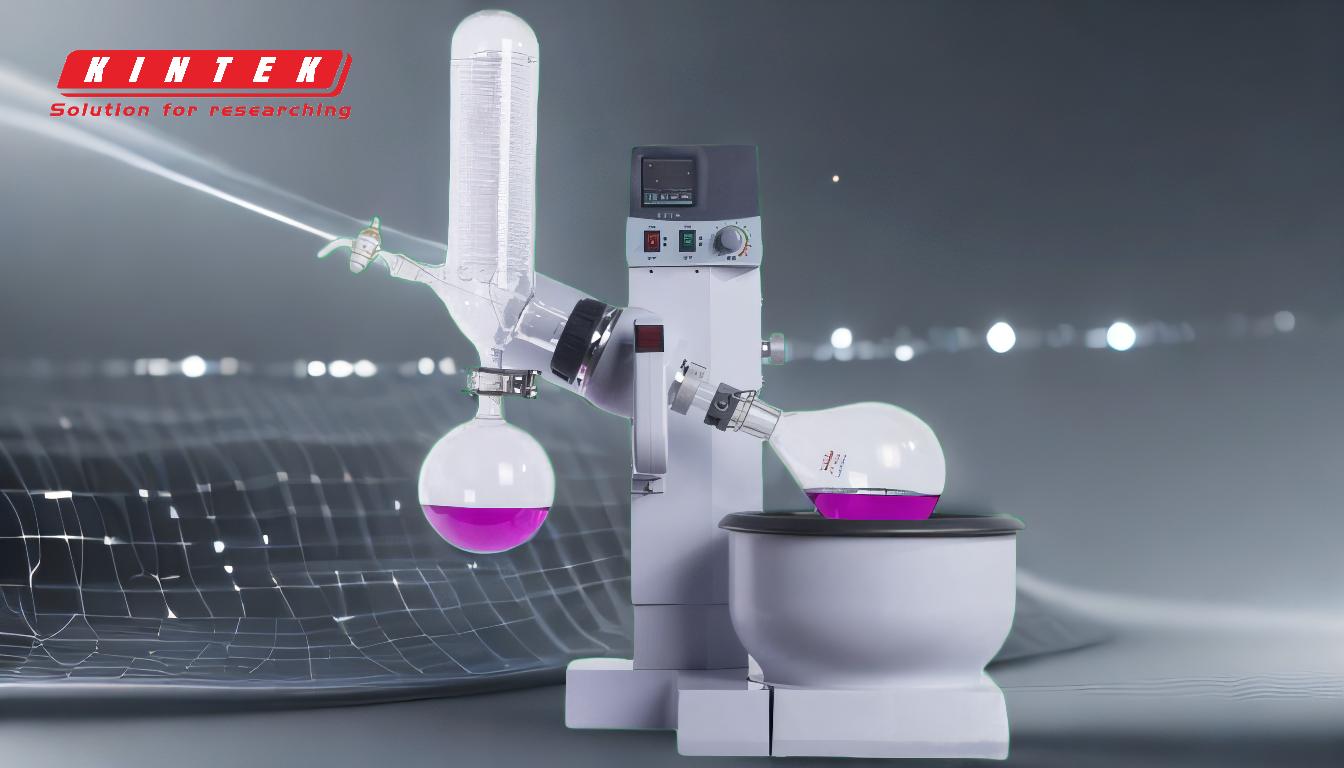A rotary evaporator reduces pressure by utilizing a vacuum pump to create a negative pressure environment within the evaporating flask. This reduction in pressure lowers the boiling point of the solvent, allowing it to evaporate at a lower temperature. The process involves rotating the flask in a heated water bath, which enhances the evaporation process by increasing the surface area of the liquid and facilitating efficient heat transfer. The solvent vapor is then condensed and collected in a separate flask, leaving behind the desired sample. This method is particularly useful for preventing thermal decomposition of sensitive compounds and for efficiently removing solvents from mixtures.
Key Points Explained:

-
Role of the Vacuum Pump:
- The vacuum pump is the core component that reduces the pressure inside the rotary evaporator system. By creating a negative pressure environment, it lowers the boiling point of the solvent, enabling evaporation at temperatures significantly below the solvent's normal boiling point.
- This is particularly beneficial for heat-sensitive compounds, as it minimizes the risk of thermal decomposition.
-
Rotating Flask Mechanism:
- The evaporating flask is rotated at a controlled speed, which increases the surface area of the liquid. This rotation enhances the evaporation process by ensuring uniform heat distribution and preventing localized overheating.
- The rotation also helps in creating a thin film of the liquid on the inner surface of the flask, which further accelerates evaporation.
-
Heated Water Bath:
- The water bath provides a controlled and constant temperature to the rotating flask. The heat from the water bath facilitates the evaporation of the solvent by supplying the necessary thermal energy.
- The temperature of the water bath is typically set below the boiling point of the solvent at atmospheric pressure but above its boiling point at the reduced pressure created by the vacuum pump.
-
Condensation and Collection:
- As the solvent evaporates, the vapor travels through the condenser, where it is cooled and condensed back into a liquid. The condensed solvent is then collected in a separate receiving flask.
- This step ensures that the solvent is effectively separated from the sample, leaving behind the desired compound in the evaporating flask.
-
Step-by-Step Operation:
- Step 1: Place the flask containing the solution on the rotary evaporator and secure it with a bump trap to prevent splashing.
- Step 2: Set the rotation speed to an appropriate level based on the volume of the solution.
- Step 3: Turn on the vacuum pump to gradually reduce the pressure inside the system.
- Step 4: Lower the flask into the heated water bath and adjust the vacuum as needed to maintain optimal evaporation conditions.
- Step 5: Collect the condensed solvent in the receiving flask.
- Step 6: Once all the solvent has evaporated, release the vacuum and stop the rotation.
-
Advantages of Reduced Pressure Evaporation:
- Efficiency: The process is faster compared to traditional evaporation methods, as the reduced pressure significantly lowers the boiling point of the solvent.
- Preservation of Sample Integrity: By operating at lower temperatures, the rotary evaporator minimizes the risk of thermal degradation, making it ideal for heat-sensitive compounds.
- Versatility: It can be used with a wide range of solvents, including water and alcohol, and is suitable for both small and large volumes (up to 3 liters).
-
Applications:
- Organic Laboratories: Commonly used for removing solvents from reaction mixtures, especially in the synthesis of organic compounds.
- Aroma Extraction: Ideal for extracting delicate aroma compounds without exposing them to high temperatures.
- Sample Preparation: Efficiently separates low boiling solvents from compounds that are solid at room temperature and pressure.
In summary, the rotary evaporator reduces pressure through the use of a vacuum pump, which lowers the boiling point of the solvent. The combination of rotation, controlled heating, and condensation ensures efficient and gentle solvent removal, making it an indispensable tool in various scientific and industrial applications.
Summary Table:
| Key Component | Function |
|---|---|
| Vacuum Pump | Creates a negative pressure environment, lowering the solvent's boiling point. |
| Rotating Flask | Increases liquid surface area for uniform evaporation and heat distribution. |
| Heated Water Bath | Provides controlled thermal energy to facilitate solvent evaporation. |
| Condenser | Cools and condenses solvent vapor for collection in a separate flask. |
| Advantages | |
| Efficiency | Faster evaporation due to reduced pressure. |
| Sample Integrity | Minimizes thermal degradation of heat-sensitive compounds. |
| Versatility | Suitable for a wide range of solvents and volumes (up to 3 liters). |
Discover how a rotary evaporator can enhance your lab's efficiency—contact us today for expert advice!










